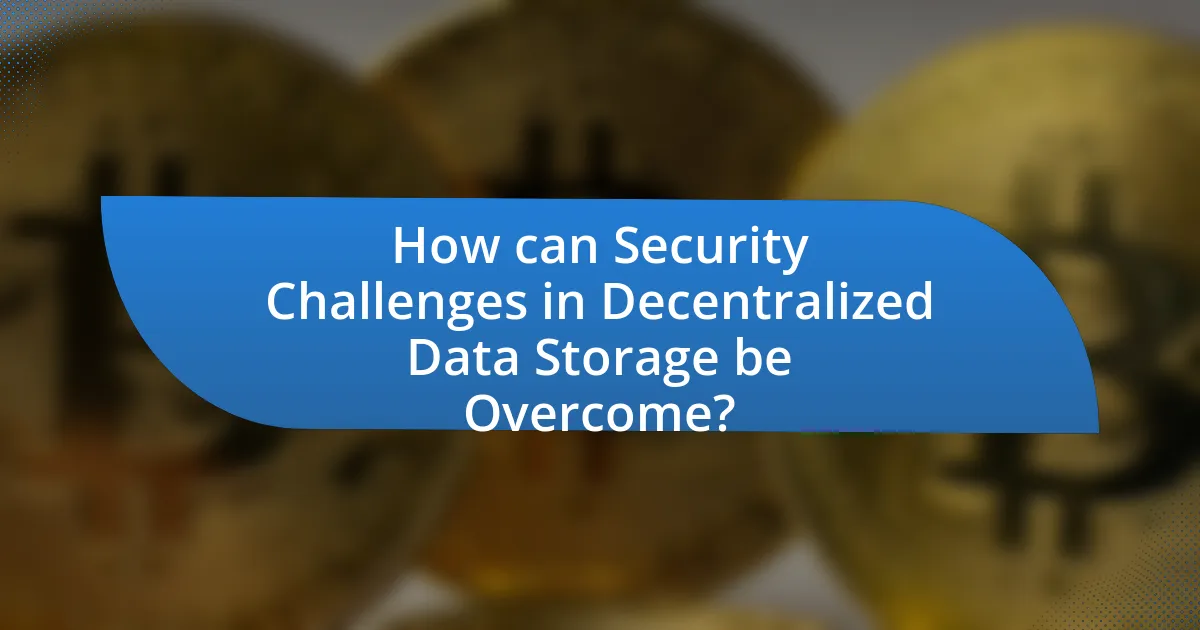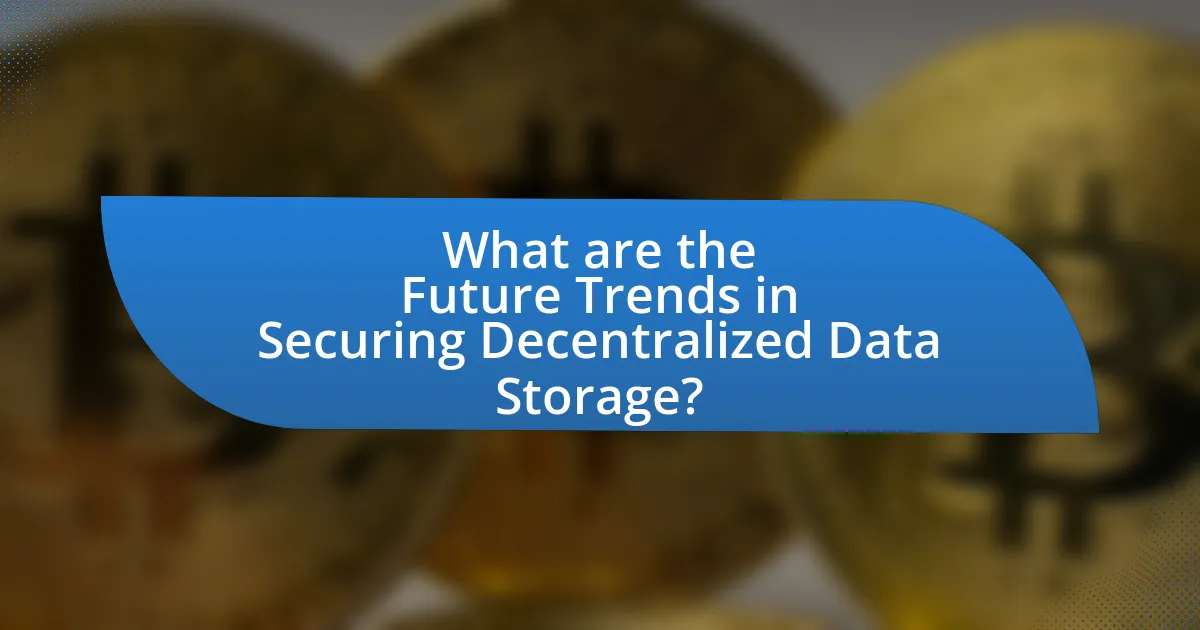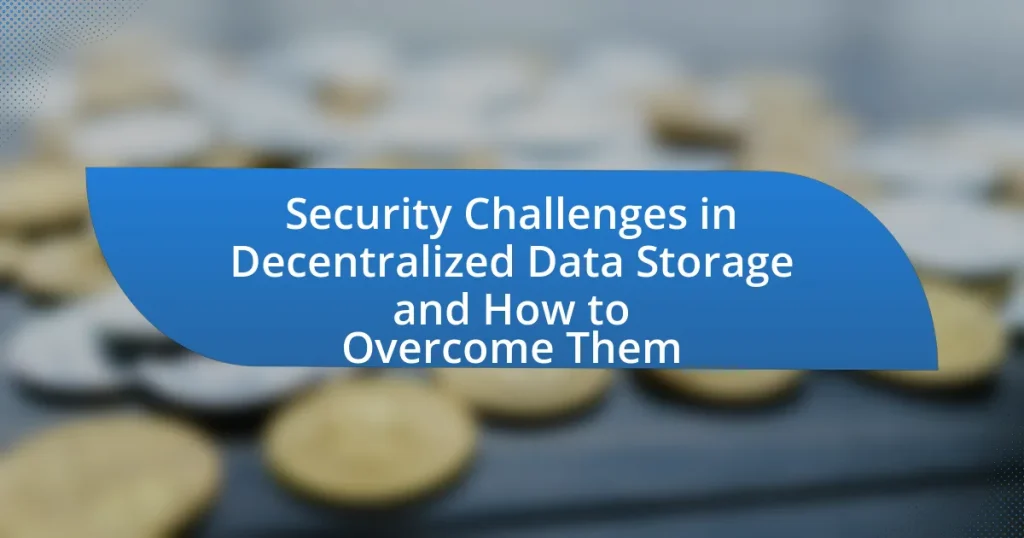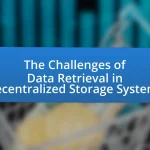The article focuses on the security challenges associated with decentralized data storage, highlighting issues such as data integrity, unauthorized access, and data availability. It examines how data breaches occur due to vulnerabilities in smart contracts, inadequate encryption, and user errors, while also discussing the importance of encryption and user authentication in safeguarding sensitive information. Additionally, the article outlines best practices for enhancing security, including regular audits, advanced encryption techniques, and user education, as well as the implications of emerging technologies and regulatory changes on data security. Overall, it provides a comprehensive overview of the vulnerabilities in decentralized storage systems and practical steps organizations can take to mitigate these risks.

What are the Security Challenges in Decentralized Data Storage?
Decentralized data storage faces several security challenges, including data integrity, unauthorized access, and data availability. Data integrity is compromised due to the lack of a central authority to verify the authenticity of stored information, making it susceptible to tampering. Unauthorized access occurs because decentralized systems often rely on cryptographic keys, which can be lost or stolen, leading to potential breaches. Additionally, data availability can be threatened by network partitions or node failures, which can hinder access to stored data. These challenges highlight the need for robust encryption methods, regular audits, and redundancy strategies to enhance security in decentralized storage systems.
How do data breaches occur in decentralized systems?
Data breaches in decentralized systems occur primarily due to vulnerabilities in smart contracts, inadequate encryption, and user errors. Smart contracts, which automate transactions, can contain coding flaws that malicious actors exploit, leading to unauthorized access to sensitive data. For instance, the DAO hack in 2016 resulted from a vulnerability in the smart contract code, leading to the loss of $60 million worth of Ether. Additionally, decentralized systems often rely on public keys for encryption; if these keys are compromised or poorly managed, attackers can decrypt sensitive information. User errors, such as sharing private keys or falling for phishing attacks, further exacerbate the risk of data breaches. According to a report by the Cybersecurity and Infrastructure Security Agency, human error is a leading cause of data breaches across all systems, including decentralized ones.
What vulnerabilities exist in decentralized data storage protocols?
Decentralized data storage protocols face several vulnerabilities, including data integrity issues, lack of encryption, and susceptibility to Sybil attacks. Data integrity can be compromised if nodes storing data become unreliable or malicious, leading to potential data corruption. Additionally, without robust encryption, sensitive information may be exposed to unauthorized access, undermining user privacy. Sybil attacks occur when an adversary creates multiple identities to gain control over a significant portion of the network, which can disrupt the consensus mechanism and lead to data manipulation. These vulnerabilities highlight the need for enhanced security measures in decentralized storage systems.
How can unauthorized access compromise data integrity?
Unauthorized access can compromise data integrity by allowing unauthorized individuals to alter, delete, or corrupt data. When individuals gain access without permission, they can manipulate information, leading to inaccuracies and loss of trust in the data. For instance, a study by the Ponemon Institute found that 60% of data breaches involved unauthorized access, which often resulted in significant data integrity issues. This manipulation can disrupt operations, lead to financial losses, and damage reputations, highlighting the critical need for robust security measures to prevent unauthorized access.
What role does encryption play in securing decentralized data?
Encryption is essential for securing decentralized data as it protects sensitive information from unauthorized access and ensures data integrity. In decentralized systems, where data is distributed across multiple nodes, encryption safeguards the data by converting it into a format that can only be read by those who possess the correct decryption keys. This process mitigates risks associated with data breaches and unauthorized modifications, which are prevalent in decentralized environments. For instance, the use of advanced encryption standards, such as AES-256, provides a robust layer of security, making it computationally infeasible for attackers to decrypt the data without the appropriate keys. Thus, encryption not only secures data at rest and in transit but also enhances user trust in decentralized systems by ensuring that only authorized parties can access or alter the information.
How effective is encryption in protecting data at rest and in transit?
Encryption is highly effective in protecting data at rest and in transit by ensuring that unauthorized users cannot access or interpret the information. When data is encrypted at rest, it is stored in a format that is unreadable without the appropriate decryption key, significantly reducing the risk of data breaches. For instance, a study by the Ponemon Institute found that organizations using encryption experienced 50% fewer data breaches compared to those that did not. In transit, encryption protocols such as TLS (Transport Layer Security) safeguard data as it moves across networks, preventing interception and tampering. According to the Internet Engineering Task Force, TLS is widely adopted and considered a standard for secure communications, further validating its effectiveness in protecting sensitive information during transmission.
What are the limitations of current encryption methods in decentralized storage?
Current encryption methods in decentralized storage face several limitations, including key management challenges, performance issues, and vulnerability to quantum attacks. Key management is complicated because users must securely store and manage their encryption keys without a central authority, increasing the risk of loss or theft. Performance issues arise as encryption and decryption processes can slow down data access and retrieval, particularly in systems with large datasets. Additionally, many existing encryption algorithms are not resistant to potential future quantum computing threats, which could render current encryption methods ineffective. These limitations highlight the need for improved encryption strategies that address these specific challenges in decentralized storage environments.
Why is user authentication critical in decentralized data storage?
User authentication is critical in decentralized data storage because it ensures that only authorized individuals can access sensitive information. In decentralized systems, where data is distributed across multiple nodes, the lack of a central authority increases the risk of unauthorized access and data breaches. Effective user authentication mechanisms, such as multi-factor authentication, help verify user identities and protect against malicious actors. According to a study by the Ponemon Institute, 63% of data breaches are linked to weak or stolen credentials, highlighting the importance of robust authentication in safeguarding decentralized data.
What authentication methods are commonly used in decentralized systems?
Common authentication methods used in decentralized systems include public key cryptography, decentralized identity protocols, and multi-signature schemes. Public key cryptography enables users to authenticate themselves using cryptographic keys, ensuring secure communication and data integrity. Decentralized identity protocols, such as Self-Sovereign Identity (SSI), allow users to manage their identities without relying on a central authority, enhancing privacy and control. Multi-signature schemes require multiple parties to authorize a transaction, increasing security by distributing trust among participants. These methods are essential for maintaining security and trust in decentralized environments.
How can weak authentication lead to security breaches?
Weak authentication can lead to security breaches by allowing unauthorized access to sensitive systems and data. When authentication mechanisms are insufficient, such as using easily guessable passwords or lacking multi-factor authentication, attackers can exploit these vulnerabilities to gain entry. For instance, a study by Verizon in their 2021 Data Breach Investigations Report found that 61% of data breaches involved credential theft, highlighting the critical role of strong authentication in preventing unauthorized access. Thus, weak authentication directly correlates with increased risk of security breaches, as it enables attackers to bypass defenses and compromise systems.

How can Security Challenges in Decentralized Data Storage be Overcome?
Security challenges in decentralized data storage can be overcome through the implementation of robust encryption techniques, decentralized identity management, and regular security audits. Encryption ensures that data remains confidential and secure from unauthorized access, as demonstrated by the use of advanced algorithms like AES-256, which is widely recognized for its strength. Decentralized identity management systems, such as those based on blockchain technology, enhance user authentication and access control, reducing the risk of identity theft. Regular security audits help identify vulnerabilities and ensure compliance with security standards, thereby maintaining the integrity of the decentralized storage system.
What best practices can enhance security in decentralized data storage?
Implementing encryption is a best practice that significantly enhances security in decentralized data storage. Encryption protects data by converting it into a format that is unreadable without the appropriate decryption key, ensuring that even if data is intercepted, it remains secure. Additionally, using decentralized identity management systems can further bolster security by allowing users to control their own identities and access permissions, reducing the risk of unauthorized access. Regularly updating software and protocols is also crucial, as it addresses vulnerabilities and strengthens defenses against potential attacks. According to a report by the International Data Corporation, organizations that adopt these security measures can reduce the risk of data breaches by up to 70%.
How can regular security audits improve system resilience?
Regular security audits enhance system resilience by identifying vulnerabilities and ensuring compliance with security policies. These audits systematically evaluate the security posture of a system, allowing organizations to detect weaknesses before they can be exploited by attackers. For instance, a study by the Ponemon Institute found that organizations conducting regular security audits experienced 30% fewer data breaches compared to those that did not. By proactively addressing identified issues, organizations can strengthen their defenses, reduce the likelihood of successful attacks, and improve their overall ability to recover from incidents.
What role does user education play in preventing security issues?
User education plays a critical role in preventing security issues by equipping individuals with the knowledge and skills necessary to recognize and mitigate potential threats. Educated users are more likely to identify phishing attempts, use strong passwords, and understand the importance of software updates, which collectively reduce the risk of security breaches. Research indicates that organizations with comprehensive security training programs experience 70% fewer security incidents compared to those without such initiatives, highlighting the effectiveness of user education in enhancing overall security posture.
How can advanced technologies mitigate security risks?
Advanced technologies can mitigate security risks by implementing robust encryption methods, utilizing artificial intelligence for threat detection, and employing blockchain for data integrity. Encryption secures data by converting it into a format that is unreadable without the correct decryption key, thus protecting sensitive information from unauthorized access. For instance, AES (Advanced Encryption Standard) is widely used and recognized for its effectiveness in safeguarding data. Artificial intelligence enhances security by analyzing patterns and identifying anomalies in real-time, which can help detect potential threats before they escalate; a study by IBM found that AI can reduce the time to identify a data breach by 27%. Blockchain technology ensures data integrity through its decentralized and immutable ledger, making it nearly impossible for malicious actors to alter data without detection. These technologies collectively strengthen security frameworks, addressing vulnerabilities inherent in decentralized data storage systems.
What is the impact of blockchain technology on data security?
Blockchain technology significantly enhances data security by providing a decentralized and immutable ledger system. This structure ensures that once data is recorded, it cannot be altered or deleted without consensus from the network, thereby reducing the risk of unauthorized access and data tampering. The cryptographic techniques used in blockchain, such as hashing and digital signatures, further protect data integrity and authenticity. According to a report by the World Economic Forum, blockchain can reduce data breaches by up to 80% due to its inherent security features.
How can artificial intelligence be utilized for threat detection?
Artificial intelligence can be utilized for threat detection by analyzing vast amounts of data in real-time to identify patterns indicative of security threats. Machine learning algorithms can be trained on historical data to recognize anomalies, such as unusual access patterns or data breaches, enabling proactive responses to potential threats. For instance, a study by IBM found that AI-driven security systems can reduce the time to detect a breach by 27% compared to traditional methods. Additionally, AI can enhance threat intelligence by correlating data from various sources, improving the accuracy of threat assessments and response strategies.

What are the Future Trends in Securing Decentralized Data Storage?
Future trends in securing decentralized data storage include the increased adoption of advanced encryption techniques, the integration of artificial intelligence for anomaly detection, and the implementation of decentralized identity solutions. Advanced encryption techniques, such as homomorphic encryption, allow data to be processed without being decrypted, enhancing security. The integration of artificial intelligence enables real-time monitoring and detection of unusual access patterns, which can indicate potential breaches. Decentralized identity solutions, leveraging blockchain technology, provide users with greater control over their data and enhance privacy. These trends are supported by the growing need for robust security measures in response to rising cyber threats and data breaches, as evidenced by the increase in ransomware attacks, which reached a record high in 2021, according to cybersecurity reports.
How are emerging technologies shaping the future of data security?
Emerging technologies are significantly enhancing data security by introducing advanced encryption methods, artificial intelligence for threat detection, and blockchain for secure data transactions. These technologies enable organizations to protect sensitive information more effectively against cyber threats. For instance, AI-driven security systems can analyze vast amounts of data in real-time to identify anomalies and potential breaches, reducing response times to incidents. Additionally, blockchain technology provides a decentralized and immutable ledger, ensuring data integrity and transparency, which is crucial for secure data storage and sharing. According to a report by Gartner, organizations that adopt AI for cybersecurity can reduce the cost of data breaches by up to 30%. This integration of emerging technologies is reshaping the landscape of data security, making it more resilient against evolving threats.
What innovations are being developed to enhance encryption methods?
Innovations being developed to enhance encryption methods include quantum encryption, homomorphic encryption, and advanced cryptographic algorithms. Quantum encryption utilizes the principles of quantum mechanics to create secure communication channels that are theoretically immune to eavesdropping, as demonstrated by research from the University of Science and Technology of China, which successfully transmitted quantum keys over long distances. Homomorphic encryption allows computations to be performed on encrypted data without needing to decrypt it first, preserving privacy while enabling data analysis, as shown in studies by IBM and Microsoft. Additionally, new cryptographic algorithms, such as lattice-based cryptography, are being explored to provide security against potential future quantum attacks, with the National Institute of Standards and Technology actively evaluating these algorithms for standardization.
How might quantum computing affect decentralized data security?
Quantum computing could significantly undermine decentralized data security by enabling the rapid decryption of cryptographic algorithms currently used to secure data. Traditional encryption methods, such as RSA and ECC, rely on the difficulty of factoring large numbers or solving discrete logarithm problems, which quantum computers can solve efficiently using algorithms like Shor’s algorithm. This capability poses a threat to the integrity and confidentiality of data stored in decentralized systems, as attackers could potentially access sensitive information and disrupt the trust model that underpins these systems. The National Institute of Standards and Technology (NIST) has recognized this risk and is actively working on post-quantum cryptography standards to mitigate the vulnerabilities introduced by quantum computing.
What regulatory changes could impact security practices in decentralized storage?
Regulatory changes such as data protection laws, anti-money laundering regulations, and cybersecurity mandates could significantly impact security practices in decentralized storage. For instance, the General Data Protection Regulation (GDPR) in the European Union imposes strict requirements on data handling and user consent, compelling decentralized storage providers to implement robust encryption and access controls to ensure compliance. Additionally, emerging regulations focused on digital assets and cryptocurrencies may require decentralized storage solutions to adopt enhanced security measures to prevent illicit activities, thereby influencing their operational frameworks.
How can compliance with regulations improve data security?
Compliance with regulations enhances data security by establishing standardized protocols that organizations must follow to protect sensitive information. These regulations, such as the General Data Protection Regulation (GDPR) and the Health Insurance Portability and Accountability Act (HIPAA), mandate specific security measures, including data encryption, access controls, and regular audits. By adhering to these requirements, organizations reduce the risk of data breaches and unauthorized access, as they are compelled to implement best practices in data handling and storage. For instance, a study by the Ponemon Institute found that organizations compliant with GDPR experienced 30% fewer data breaches compared to those that were not compliant, demonstrating the effectiveness of regulatory frameworks in bolstering data security.
What are the implications of data privacy laws on decentralized systems?
Data privacy laws significantly impact decentralized systems by imposing compliance requirements that challenge their inherent design. Decentralized systems, which prioritize user autonomy and data control, must navigate regulations such as the General Data Protection Regulation (GDPR) that mandate data protection measures, user consent, and the right to be forgotten. For instance, GDPR requires organizations to ensure that personal data is processed lawfully, which can conflict with the immutable nature of blockchain technology used in many decentralized systems. This creates a tension between maintaining data integrity and adhering to legal obligations, as seen in cases where data must be deleted upon user request, yet cannot be removed from a blockchain. Consequently, decentralized systems may need to implement complex solutions, such as off-chain storage or data encryption, to comply with these laws while preserving their core functionalities.
What practical steps can organizations take to secure decentralized data storage?
Organizations can secure decentralized data storage by implementing robust encryption protocols, ensuring that data is encrypted both at rest and in transit. This step protects sensitive information from unauthorized access, as encryption transforms data into a format that is unreadable without the appropriate decryption key. Additionally, organizations should adopt multi-signature authentication methods, which require multiple approvals for data access, thereby reducing the risk of single points of failure. Regular audits and monitoring of access logs can further enhance security by identifying and addressing potential vulnerabilities in real-time. Furthermore, employing decentralized identity solutions can help verify user identities without relying on a central authority, thus minimizing the risk of data breaches. These measures collectively contribute to a more secure decentralized data storage environment.


